2004 DAEWOO NUBIRA gas
[x] Cancel search: gasPage 2551 of 2643
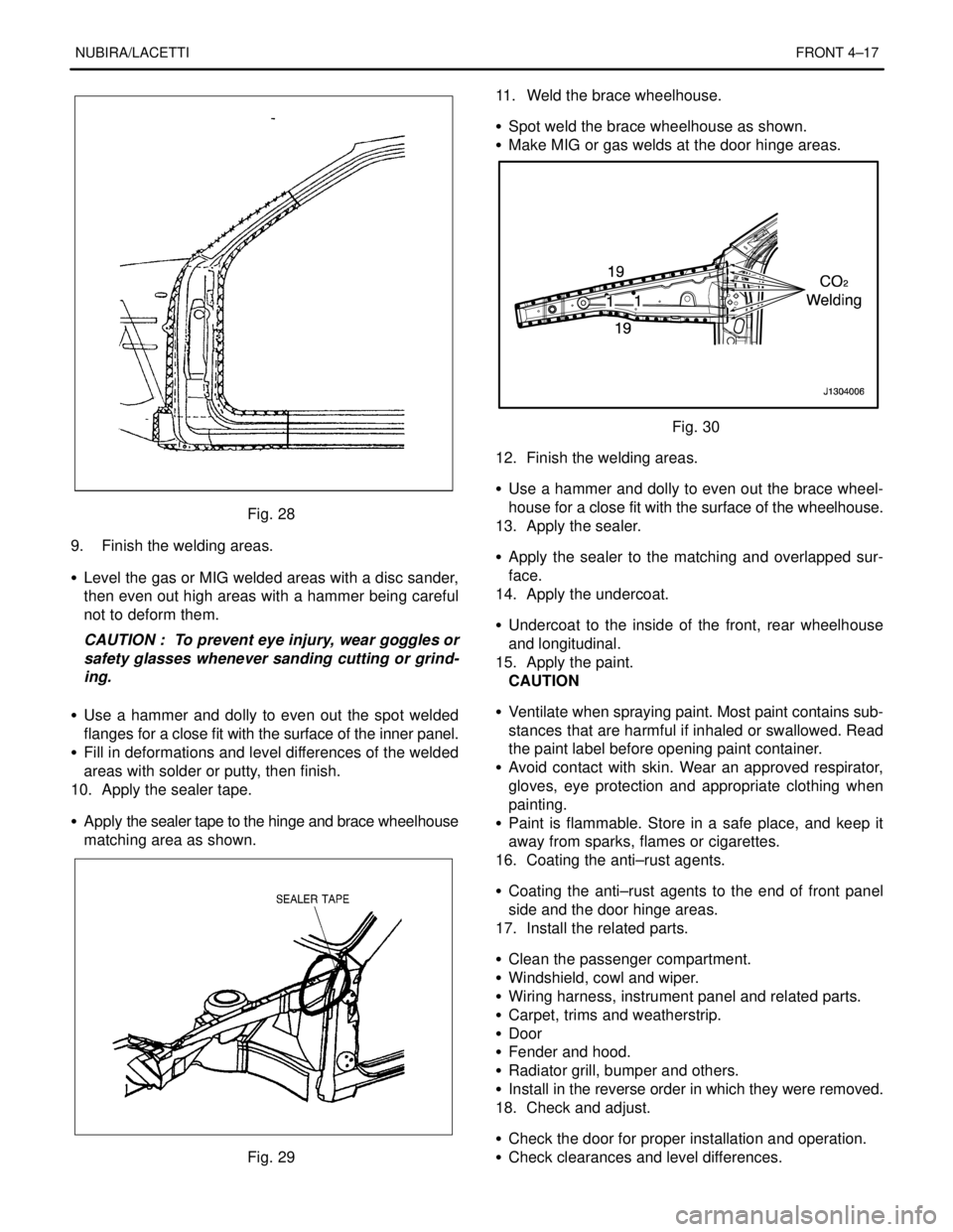
NUBIRA/LACETTIFRONT 4–17
Fig. 28
9. Finish the welding areas.
S Level the gas or MIG welded areas with a disc sander,
then even out high areas with a hammer being careful
not to deform them.
CAUTION : To prevent eye injury, wear goggles or
safety glasses whenever sanding cutting or grind-
ing.
S Use a hammer and dolly to even out the spot welded
flanges for a close fit with the surface of the inner panel.
S Fill in deformations and level differences of the welded
areas with solder or putty, then finish.
10. Apply the sealer tape.
S Apply the sealer tape to the hinge and brace wheelhouse
matching area as shown.
Fig. 2911. Weld the brace wheelhouse.
S Spot weld the brace wheelhouse as shown.
S Make MIG or gas welds at the door hinge areas.
Fig. 30
12. Finish the welding areas.
S Use a hammer and dolly to even out the brace wheel-
house for a close fit with the surface of the wheelhouse.
13. Apply the sealer.
S Apply the sealer to the matching and overlapped sur-
face.
14. Apply the undercoat.
S Undercoat to the inside of the front, rear wheelhouse
and longitudinal.
15. Apply the paint.
CAUTION
S Ventilate when spraying paint. Most paint contains sub-
stances that are harmful if inhaled or swallowed. Read
the paint label before opening paint container.
S Avoid contact with skin. Wear an approved respirator,
gloves, eye protection and appropriate clothing when
painting.
S Paint is flammable. Store in a safe place, and keep it
away from sparks, flames or cigarettes.
16. Coating the anti–rust agents.
S Coating the anti–rust agents to the end of front panel
side and the door hinge areas.
17. Install the related parts.
S Clean the passenger compartment.
S Windshield, cowl and wiper.
S Wiring harness, instrument panel and related parts.
S Carpet, trims and weatherstrip.
S Door
S Fender and hood.
S Radiator grill, bumper and others.
S Install in the reverse order in which they were removed.
18. Check and adjust.
S Check the door for proper installation and operation.
S Check clearances and level differences.
Page 2559 of 2643
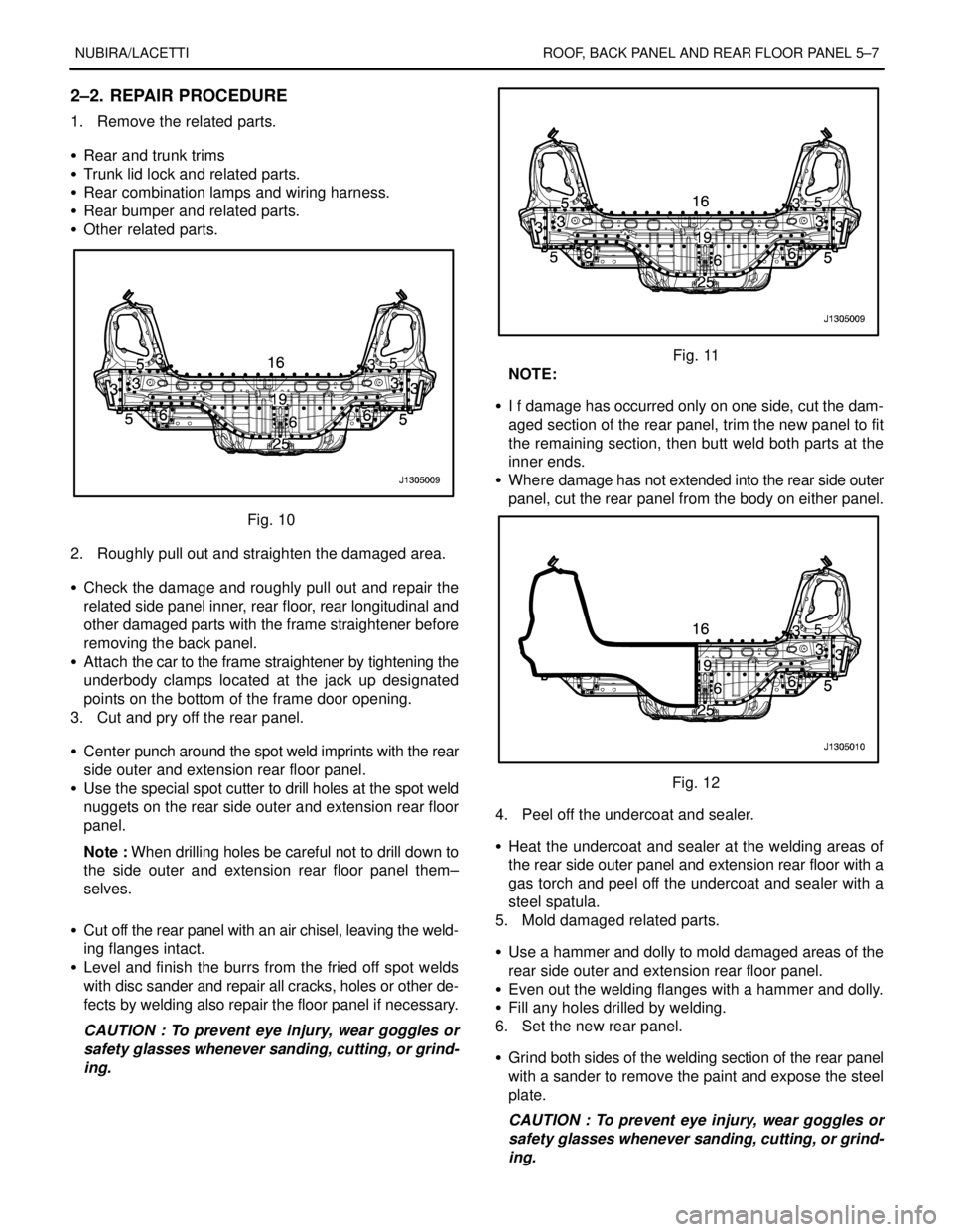
NUBIRA/LACETTI ROOF, BACK PANEL AND REAR FLOOR PANEL 5–7
2–2. REPAIR PROCEDURE
1. Remove the related parts.
S Rear and trunk trims
S Trunk lid lock and related parts.
S Rear combination lamps and wiring harness.
S Rear bumper and related parts.
S Other related parts.
Fig. 10
2. Roughly pull out and straighten the damaged area.
S Check the damage and roughly pull out and repair the
related side panel inner, rear floor, rear longitudinal and
other damaged parts with the frame straightener before
removing the back panel.
S Attach the car to the frame straightener by tightening the
underbody clamps located at the jack up designated
points on the bottom of the frame door opening.
3. Cut and pry off the rear panel.
S Center punch around the spot weld imprints with the rear
side outer and extension rear floor panel.
S Use the special spot cutter to drill holes at the spot weld
nuggets on the rear side outer and extension rear floor
panel.
Note : When drilling holes be careful not to drill down to
the side outer and extension rear floor panel them–
selves.
S Cut off the rear panel with an air chisel, leaving the weld-
ing flanges intact.
S Level and finish the burrs from the fried off spot welds
with disc sander and repair all cracks, holes or other de-
fects by welding also repair the floor panel if necessary.
CAUTION : To prevent eye injury, wear goggles or
safety glasses whenever sanding, cutting, or grind-
ing.
Fig. 11
NOTE:
S I f damage has occurred only on one side, cut the dam-
aged section of the rear panel, trim the new panel to fit
the remaining section, then butt weld both parts at the
inner ends.
S Where damage has not extended into the rear side outer
panel, cut the rear panel from the body on either panel.
Fig. 12
4. Peel off the undercoat and sealer.
S Heat the undercoat and sealer at the welding areas of
the rear side outer panel and extension rear floor with a
gas torch and peel off the undercoat and sealer with a
steel spatula.
5. Mold damaged related parts.
S Use a hammer and dolly to mold damaged areas of the
rear side outer and extension rear floor panel.
S Even out the welding flanges with a hammer and dolly.
S Fill any holes drilled by welding.
6. Set the new rear panel.
S Grind both sides of the welding section of the rear panel
with a sander to remove the paint and expose the steel
plate.
CAUTION : To prevent eye injury, wear goggles or
safety glasses whenever sanding, cutting, or grind-
ing.
Page 2560 of 2643
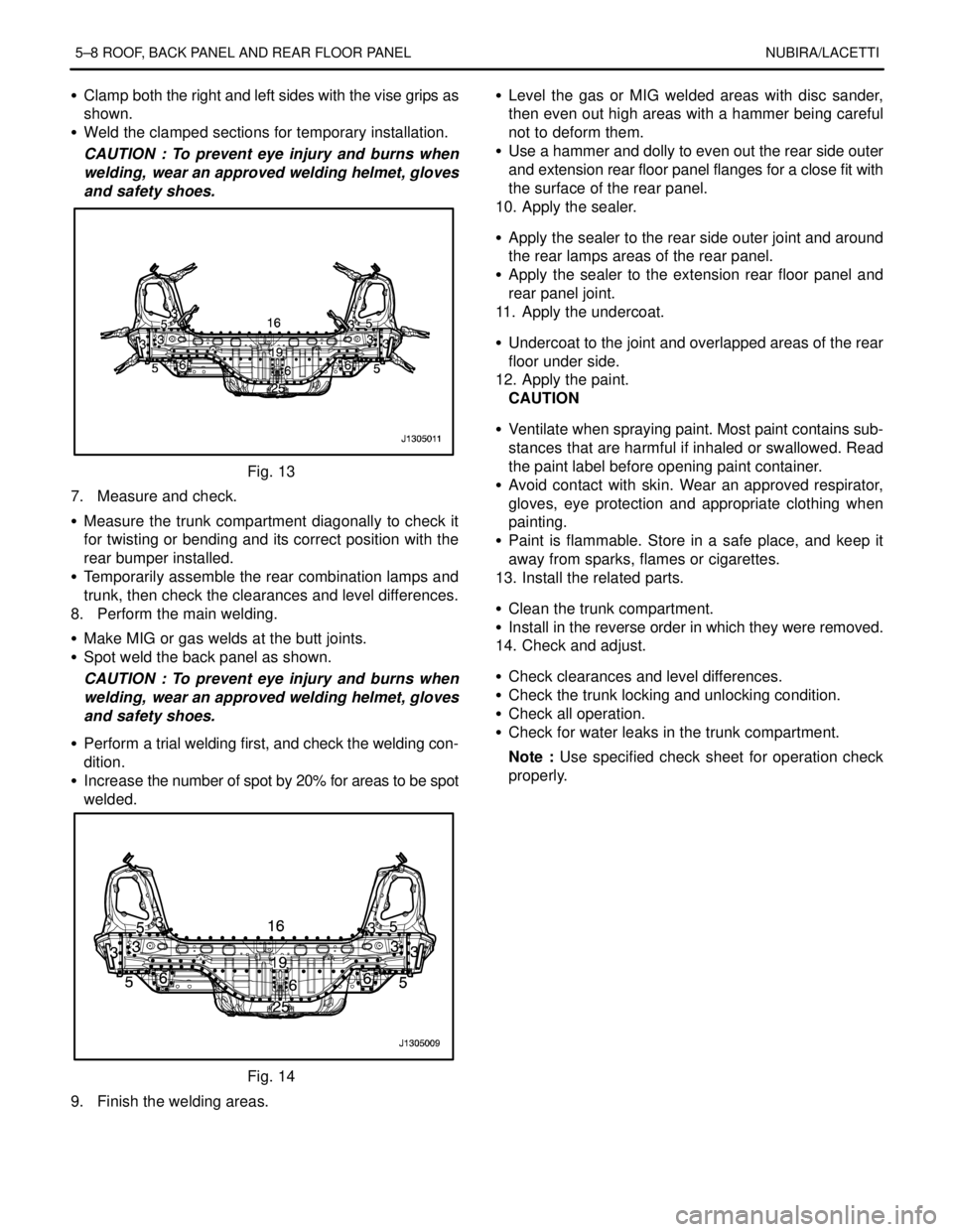
5–8 ROOF, BACK PANEL AND REAR FLOOR PANEL NUBIRA/LACETTI
S Clamp both the right and left sides with the vise grips as
shown.
S Weld the clamped sections for temporary installation.
CAUTION : To prevent eye injury and burns when
welding, wear an approved welding helmet, gloves
and safety shoes.
Fig. 13
7. Measure and check.
S Measure the trunk compartment diagonally to check it
for twisting or bending and its correct position with the
rear bumper installed.
S Temporarily assemble the rear combination lamps and
trunk, then check the clearances and level differences.
8. Perform the main welding.
S Make MIG or gas welds at the butt joints.
S Spot weld the back panel as shown.
CAUTION : To prevent eye injury and burns when
welding, wear an approved welding helmet, gloves
and safety shoes.
S Perform a trial welding first, and check the welding con-
dition.
S Increase the number of spot by 20% for areas to be spot
welded.
Fig. 14
9. Finish the welding areas.S Level the gas or MIG welded areas with disc sander,
then even out high areas with a hammer being careful
not to deform them.
S Use a hammer and dolly to even out the rear side outer
and extension rear floor panel flanges for a close fit with
the surface of the rear panel.
10. Apply the sealer.
S Apply the sealer to the rear side outer joint and around
the rear lamps areas of the rear panel.
S Apply the sealer to the extension rear floor panel and
rear panel joint.
11. Apply the undercoat.
S Undercoat to the joint and overlapped areas of the rear
floor under side.
12. Apply the paint.
CAUTION
S Ventilate when spraying paint. Most paint contains sub-
stances that are harmful if inhaled or swallowed. Read
the paint label before opening paint container.
S Avoid contact with skin. Wear an approved respirator,
gloves, eye protection and appropriate clothing when
painting.
S Paint is flammable. Store in a safe place, and keep it
away from sparks, flames or cigarettes.
13. Install the related parts.
S Clean the trunk compartment.
S Install in the reverse order in which they were removed.
14. Check and adjust.
S Check clearances and level differences.
S Check the trunk locking and unlocking condition.
S Check all operation.
S Check for water leaks in the trunk compartment.
Note : Use specified check sheet for operation check
properly.
Page 2563 of 2643
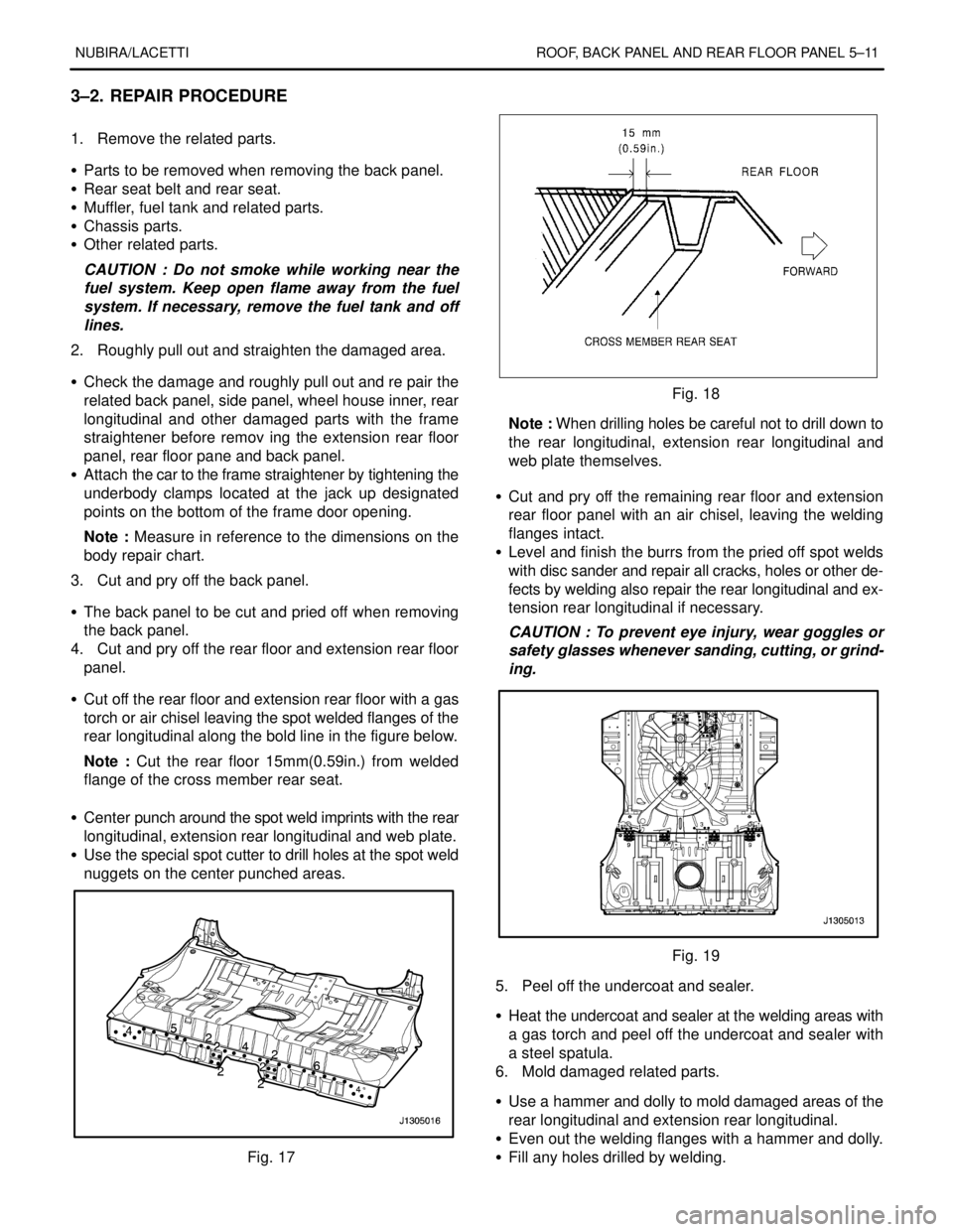
NUBIRA/LACETTI ROOF, BACK PANEL AND REAR FLOOR PANEL 5–11
3–2. REPAIR PROCEDURE
1. Remove the related parts.
S Parts to be removed when removing the back panel.
S Rear seat belt and rear seat.
S Muffler, fuel tank and related parts.
S Chassis parts.
S Other related parts.
CAUTION : Do not smoke while working near the
fuel system. Keep open flame away from the fuel
system. If necessary, remove the fuel tank and off
lines.
2. Roughly pull out and straighten the damaged area.
S Check the damage and roughly pull out and re pair the
related back panel, side panel, wheel house inner, rear
longitudinal and other damaged parts with the frame
straightener before remov ing the extension rear floor
panel, rear floor pane and back panel.
S Attach the car to the frame straightener by tightening the
underbody clamps located at the jack up designated
points on the bottom of the frame door opening.
Note : Measure in reference to the dimensions on the
body repair chart.
3. Cut and pry off the back panel.
S The back panel to be cut and pried off when removing
the back panel.
4. Cut and pry off the rear floor and extension rear floor
panel.
S Cut off the rear floor and extension rear floor with a gas
torch or air chisel leaving the spot welded flanges of the
rear longitudinal along the bold line in the figure below.
Note : Cut the rear floor 15mm(0.59in.) from welded
flange of the cross member rear seat.
S Center punch around the spot weld imprints with the rear
longitudinal, extension rear longitudinal and web plate.
S Use the special spot cutter to drill holes at the spot weld
nuggets on the center punched areas.
Fig. 17
Fig. 18
Note : When drilling holes be careful not to drill down to
the rear longitudinal, extension rear longitudinal and
web plate themselves.
S Cut and pry off the remaining rear floor and extension
rear floor panel with an air chisel, leaving the welding
flanges intact.
S Level and finish the burrs from the pried off spot welds
with disc sander and repair all cracks, holes or other de-
fects by welding also repair the rear longitudinal and ex-
tension rear longitudinal if necessary.
CAUTION : To prevent eye injury, wear goggles or
safety glasses whenever sanding, cutting, or grind-
ing.
Fig. 19
5. Peel off the undercoat and sealer.
S Heat the undercoat and sealer at the welding areas with
a gas torch and peel off the undercoat and sealer with
a steel spatula.
6. Mold damaged related parts.
S Use a hammer and dolly to mold damaged areas of the
rear longitudinal and extension rear longitudinal.
S Even out the welding flanges with a hammer and dolly.
S Fill any holes drilled by welding.
Page 2569 of 2643
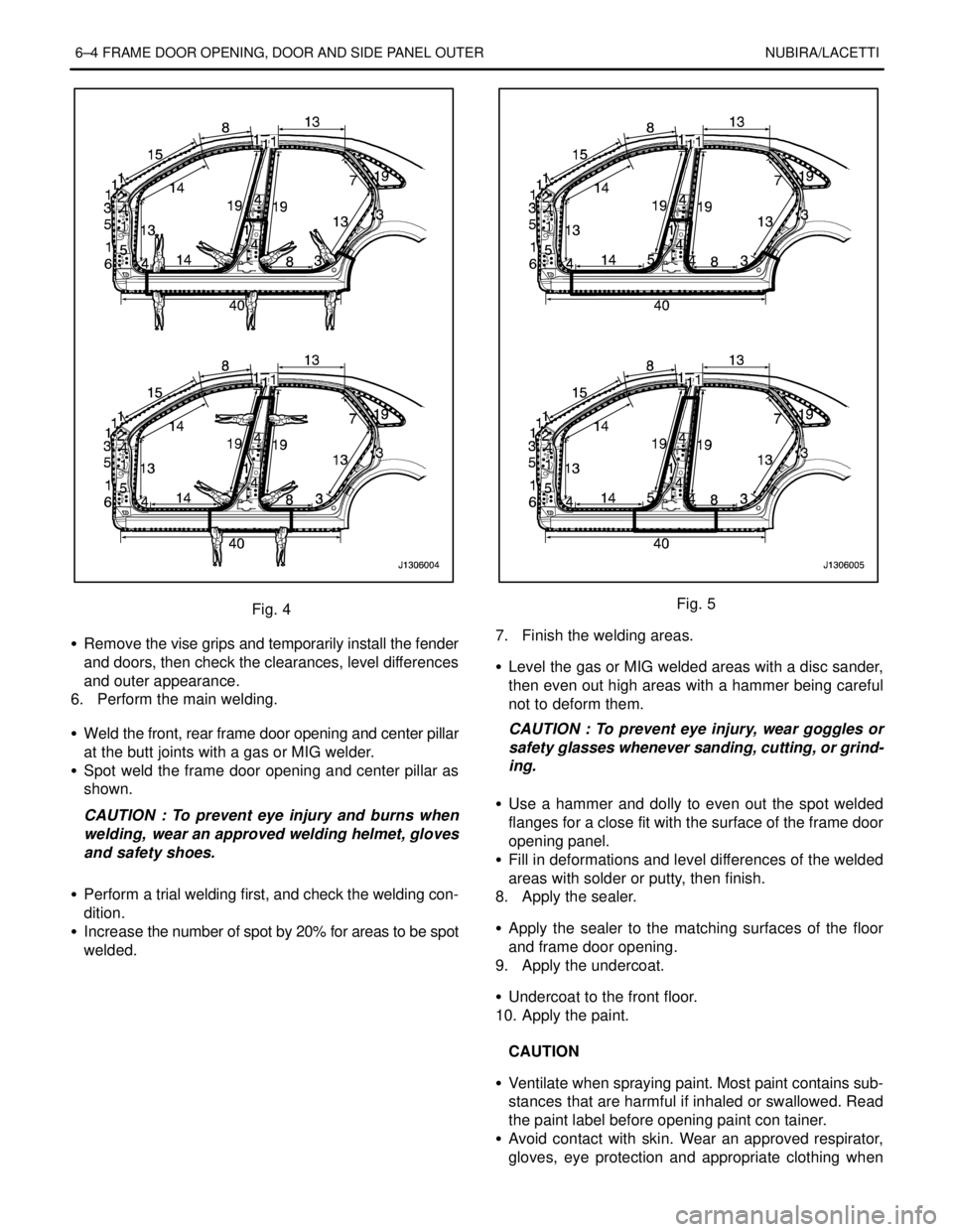
6–4 FRAME DOOR OPENING, DOOR AND SIDE PANEL OUTER NUBIRA/LACETTI
Fig. 4
S Remove the vise grips and temporarily install the fender
and doors, then check the clearances, level differences
and outer appearance.
6. Perform the main welding.
S Weld the front, rear frame door opening and center pillar
at the butt joints with a gas or MIG welder.
S Spot weld the frame door opening and center pillar as
shown.
CAUTION : To prevent eye injury and burns when
welding, wear an approved welding helmet, gloves
and safety shoes.
S Perform a trial welding first, and check the welding con-
dition.
S Increase the number of spot by 20% for areas to be spot
welded.Fig. 5
7. Finish the welding areas.
S Level the gas or MIG welded areas with a disc sander,
then even out high areas with a hammer being careful
not to deform them.
CAUTION : To prevent eye injury, wear goggles or
safety glasses whenever sanding, cutting, or grind-
ing.
S Use a hammer and dolly to even out the spot welded
flanges for a close fit with the surface of the frame door
opening panel.
S Fill in deformations and level differences of the welded
areas with solder or putty, then finish.
8. Apply the sealer.
S Apply the sealer to the matching surfaces of the floor
and frame door opening.
9. Apply the undercoat.
S Undercoat to the front floor.
10. Apply the paint.
CAUTION
S Ventilate when spraying paint. Most paint contains sub-
stances that are harmful if inhaled or swallowed. Read
the paint label before opening paint con tainer.
S Avoid contact with skin. Wear an approved respirator,
gloves, eye protection and appropriate clothing when
Page 2576 of 2643
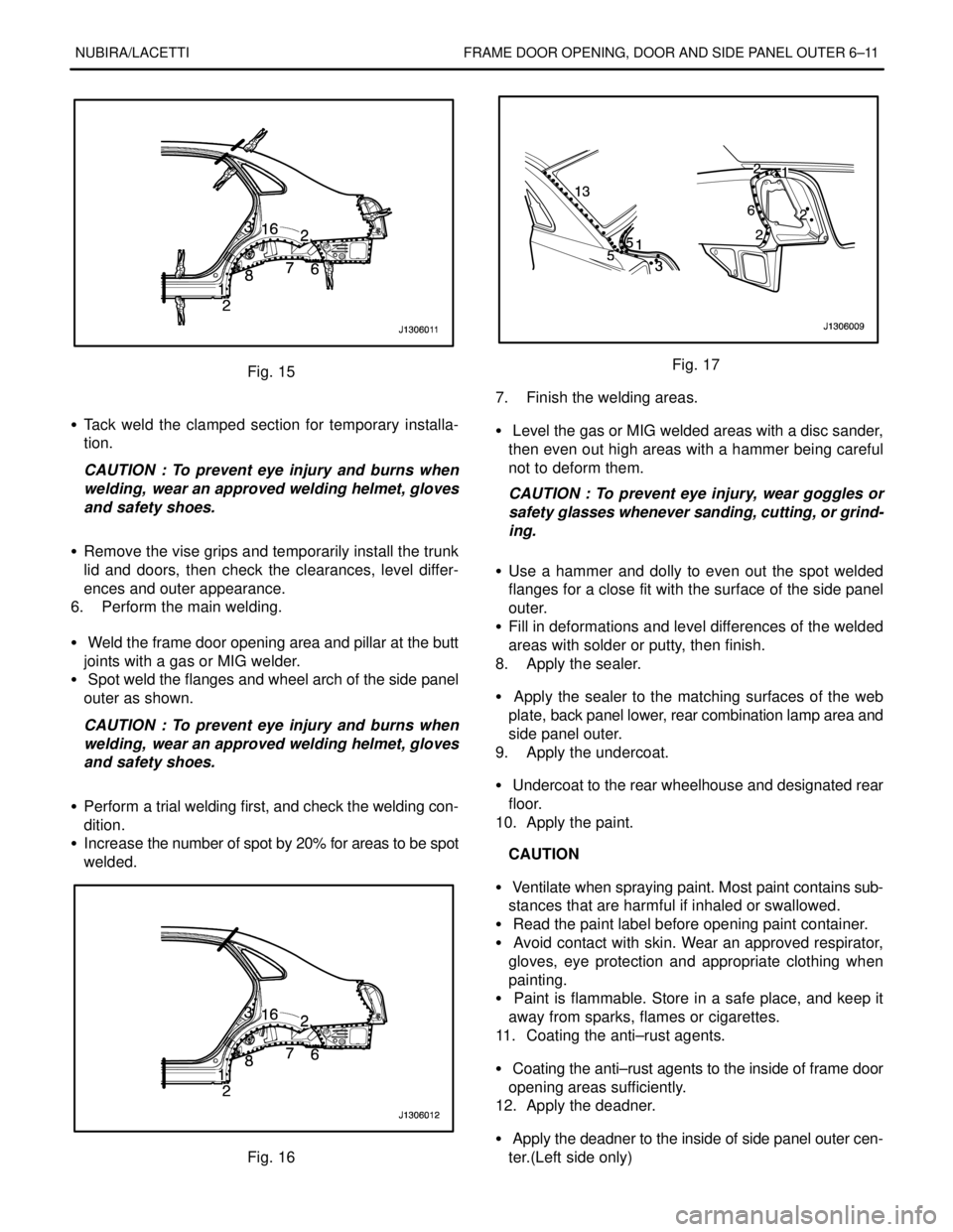
NUBIRA/LACETTI FRAME DOOR OPENING, DOOR AND SIDE PANEL OUTER 6–11
Fig. 15
S Tack weld the clamped section for temporary installa-
tion.
CAUTION : To prevent eye injury and burns when
welding, wear an approved welding helmet, gloves
and safety shoes.
S Remove the vise grips and temporarily install the trunk
lid and doors, then check the clearances, level differ-
ences and outer appearance.
6. Perform the main welding.
S Weld the frame door opening area and pillar at the butt
joints with a gas or MIG welder.
S Spot weld the flanges and wheel arch of the side panel
outer as shown.
CAUTION : To prevent eye injury and burns when
welding, wear an approved welding helmet, gloves
and safety shoes.
S Perform a trial welding first, and check the welding con-
dition.
S Increase the number of spot by 20% for areas to be spot
welded.
Fig. 16
Fig. 17
7. Finish the welding areas.
S Level the gas or MIG welded areas with a disc sander,
then even out high areas with a hammer being careful
not to deform them.
CAUTION : To prevent eye injury, wear goggles or
safety glasses whenever sanding, cutting, or grind-
ing.
S Use a hammer and dolly to even out the spot welded
flanges for a close fit with the surface of the side panel
outer.
S Fill in deformations and level differences of the welded
areas with solder or putty, then finish.
8. Apply the sealer.
S Apply the sealer to the matching surfaces of the web
plate, back panel lower, rear combination lamp area and
side panel outer.
9. Apply the undercoat.
S Undercoat to the rear wheelhouse and designated rear
floor.
10. Apply the paint.
CAUTION
S Ventilate when spraying paint. Most paint contains sub-
stances that are harmful if inhaled or swallowed.
S Read the paint label before opening paint container.
S Avoid contact with skin. Wear an approved respirator,
gloves, eye protection and appropriate clothing when
painting.
S Paint is flammable. Store in a safe place, and keep it
away from sparks, flames or cigarettes.
11. Coating the anti–rust agents.
S Coating the anti–rust agents to the inside of frame door
opening areas sufficiently.
12. Apply the deadner.
S Apply the deadner to the inside of side panel outer cen-
ter.(Left side only)